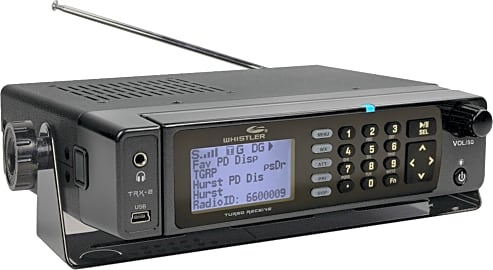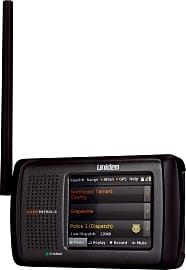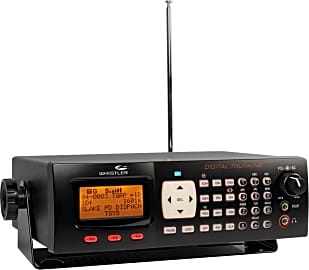The 10 Best Radio Scanners

This wiki has been updated 42 times since it was first published in July of 2015. Ideal for monitoring police and other emergency personnel, along with air traffic control, weather alerts, and even NASCAR driver communications, these radio scanners will keep you in the know and up to date. And if the zombie apocalypse ever comes, they might just be the only thing to lead you to a safe haven. We've ranked them here by range, programming abilities, and special features. When users buy our independently chosen editorial picks, we may earn commissions to help fund the Wiki.
Editor's Notes
July 22, 2020:
There's going to be a pretty big dividing line between scanners geared toward new users and those that are designed with more experienced operators in mind. Remember, of course, that these devices aren't meant to transmit the way UHF or VHF radios can. The Uniden Digital TT, which comes with the kind of hardware you'd expect for a model that can aid storm chasers, can also be a pain to program, especially for newbies. Something like the Whistler WS1065 Desktop would have a similar problem if it weren't for the addition of help text that explains key functions as you move through its menus.
The best option for those who are both completely new to the pastime and a little intimidated by the tech is probably the Uniden Home Patrol II, with its intuitive interface and simple setup. Serious users will want more than mere complexity, however. Things like the ability to record audio to an SD card, or to stand up to the elements are paramount. The mobile beast that is the Uniden SDS100 boasts an IPX4 weatherproof rating, so it should be fine if you're using it in a tornado.
The only real update any of the models from our last ranking have seen, however, is in the Whistler TRX-1 Handheld Digital, which is here to replace the company's WS1080. The big difference between the two is the addition of a numeric keypad, which dramatically cuts down on programming time. It also comes with better protective inserts than its predecessor.
August 09, 2019:
With a few new models on the market, Uniden continues to dominate the sector, and their latest creations include things like full-color displays with touchscreen capabilities. Availability issues sent the Whistler WS1095 packing, and Uniden upgraded their XLT model to include a clearer display and an additional 200 channels. It's the Uniden SDS200 that really takes the cake here, though, with a big, colorful readout and free software that keeps is comprehensive database up to date. The SDS100 is basically a handheld version of the same thing, albiet with a smaller screen and no Ethernet control.
A Brief Explanation Of Radio Frequencies
All FM radio stations transmit in the band of frequencies between 88 megahertz and 108 megahertz.
You can’t see them, but thousands of radio waves are swirling around you at this moment. Any type of gadget that needs to transmit a signal – from televisions to baby monitors – uses radio waves to send it. Your typical, single-purpose radio won’t pick up on the cooing of an infant over a monitor because it doesn’t detect radio waves within that device’s frequency. That's because the Federal Communications Commission determines who can use which frequencies, and for what purposes.
When you listen to your FM or AM radio, you will often hear the announcer say, “You’re listening to 93.1 WKRZ or 97.9 WFMX.” Those number aren’t arbitrary; they represent megahertz, which means millions of cycles per second. The transmitter at that particular radio station is oscillating at a frequency of 93,100,000 or 97,900,000 cycles per second respectively. All FM radio stations transmit in the band of frequencies between 88 megahertz and 108 megahertz. AM stations transmit between 535 kilohertz and 1,700 kilohertz, which means thousands of cycles per second. If you try to tune your FM or AM radio to frequencies outside of these bands, you will not be able to do it. That’s because the FCC leases frequencies to certain stations and devices, and it doesn’t allow your device to access frequencies that are not withing the specified bandwidth.
FM and AM radio by no means make up the entire spectrum of frequencies. Garage doors, for example, operate at around 40 megahertz. Radio controlled cars operate at 75 megahertz, animal tracking collars transmit a signal between 215 and 220 megahertz, and your GPS transmits within the band of 1,227 and 1,575 megahertz. Radio scanners are unique because they can detect signals that are meant to remain private.
The Unique And Controversial Uses For Radio Scanners
Radio scanners are quite popular among NASCAR fans who like to listen in on the race. The device allows the listener tune in to the car-to-car communications between the drivers, hearing every in-depth detail about what is going on inside of the vehicle.
The device allows the listener tune in to the car-to-car communications between the drivers, hearing every in-depth detail about what is going on inside of the vehicle.
Police and criminals alike listen to one another’s frequency bands through radio scanners. Criminals who are hoping to track the location of law enforcement, in order to escape them and efficiently carry out a plan, might scan for the private police radio. Police can listen into the handheld transceivers, often called a walkie-talkie that the criminals use. Police can sit in a neighborhood where they presume criminal activity is taking place, and use their radio scanner to pick up on any walkie-talkie frequencies in the vicinity. If they hear one that they think is the criminal’s, they’ll stay on it.
Most apocalypse believers have a radio scanner in their emergency kit. Regardless of your belief in such an event, a radio scanner could save your life in the midst of a national disaster, when cell phone towers are not working. Since the tool can pick up on a wide range of radio frequencies, it can help you determine if there is help nearby. If you're hurt, you can tune your scanner until you land on the transmission from an emergency medical service team, listen in to determine their location, and go there for aid.
If you are ever caught in a city-wide disaster you can tune into private stations and find out what's happening. You might discover there is a bomb threat in your neighborhood that the police are trying to conceal. Civilians have been monitoring local activity through police radio for years.
The History Of The Radio Scanner
Current radio scanners can pick up on the most covert of stations, including military and air traffic control, but the first model wasn’t so advanced. Scanners first became popular during the heyday of Citizens Band Radio in the 1970s. The first model required crystal radio receivers – one of the most popular types of radio receivers in the earliest days of radio. A separate crystal was needed for each frequency the listener wanted to pick up, and cost around five bucks.
Early users of the device mostly wanted a scanner to listen in on their local police stations, which is why radio scanners are also known as police scanners. By the 1980s, some scanners were capable of detecting up to 20 channels, but in 1986 Radio Shack shocked the consumer market when they released the PRO-2004 – a scanner capable of picking up 300 channels.
Shortly after the PRO-2004 hit the market, Uniden released a scanner called the Bearcat BC200XLT that could receive the 800 MHz scanner band.















